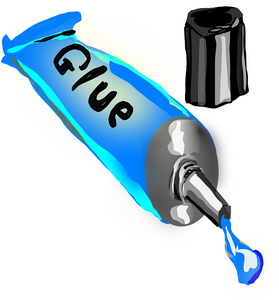 What is collagen and why are so many people taking it? Simply put, collagen is a type of protein your body uses to make skin, bones, joints, organs, and hair. It is the stuff that holds everything together. Those of us sneaking up on aging are well aware of how our stuff does not hold together quite like it used to. Parts that used to be tight and firm are sagging and dragging. Well, the glue that holds everything in place and upright is collagen. Even our bones are mostly collagen. The minerals like calcium in our bones are held in place by collagen.
What is collagen and why are so many people taking it? Simply put, collagen is a type of protein your body uses to make skin, bones, joints, organs, and hair. It is the stuff that holds everything together. Those of us sneaking up on aging are well aware of how our stuff does not hold together quite like it used to. Parts that used to be tight and firm are sagging and dragging. Well, the glue that holds everything in place and upright is collagen. Even our bones are mostly collagen. The minerals like calcium in our bones are held in place by collagen.
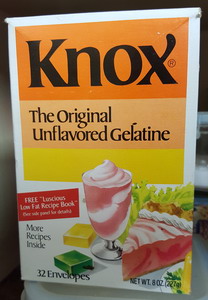 Back in prehistoric times, like the ’60s and ’70s, beauty-conscious people knew to take Knox gelatin (a collagen) to strengthen their hair and nails. That was pretty much the extent of the consumer awareness of collagen back then. Quite a bit of research knowledge has been added since those days. Now collagen is a first line of defense against wrinkles, sagging body parts, achy joints, and weak bones. The first piece to understand about collagen is that not all proteins are alike. The amino acid building blocks of collagen are different from muscle meat’s building blocks. So if all you ate was just meat, you would not be supporting the collagen levels sufficiently in your body. And sorry, there are no natural vegan sources of collagen. Some companies have spliced human DNA into yeast to be able to produce a GMO version of vegan collagen. I am not ready for Frankenstein food just yet, but future colonists on Mars will probably be eating all sorts of genetically modified yeasts and algae.
Back in prehistoric times, like the ’60s and ’70s, beauty-conscious people knew to take Knox gelatin (a collagen) to strengthen their hair and nails. That was pretty much the extent of the consumer awareness of collagen back then. Quite a bit of research knowledge has been added since those days. Now collagen is a first line of defense against wrinkles, sagging body parts, achy joints, and weak bones. The first piece to understand about collagen is that not all proteins are alike. The amino acid building blocks of collagen are different from muscle meat’s building blocks. So if all you ate was just meat, you would not be supporting the collagen levels sufficiently in your body. And sorry, there are no natural vegan sources of collagen. Some companies have spliced human DNA into yeast to be able to produce a GMO version of vegan collagen. I am not ready for Frankenstein food just yet, but future colonists on Mars will probably be eating all sorts of genetically modified yeasts and algae.
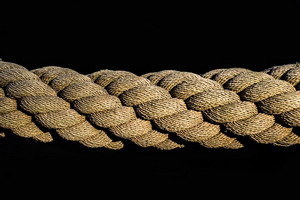 Collagen is primarily made from the amino acids glycine, proline, lysine, and hydroxyproline, which string together into a triple helix. This is a very strong yet flexible combination that gives collagen its useful properties. There are 28 different kinds of collagen. The most common in our bodies are types 1 – 4. Type 1 is found in all connective tissue, type 2 is found mostly in joints and spinal discs, type 3 is found in blood vessels and fibers in your skin, and type 4 is found in kidneys, inner ear, and the eye lens. Collagens are formed by specialized cells called fibroblasts that wander around laying down collagen where needed in the body.
Collagen is primarily made from the amino acids glycine, proline, lysine, and hydroxyproline, which string together into a triple helix. This is a very strong yet flexible combination that gives collagen its useful properties. There are 28 different kinds of collagen. The most common in our bodies are types 1 – 4. Type 1 is found in all connective tissue, type 2 is found mostly in joints and spinal discs, type 3 is found in blood vessels and fibers in your skin, and type 4 is found in kidneys, inner ear, and the eye lens. Collagens are formed by specialized cells called fibroblasts that wander around laying down collagen where needed in the body.
 These collagen fibers not only hold everything together, but they also form a kind of cellular communication network to guide cellular repair and immune function as well as trigger cellular repair after an injury. The problem with aging is that various accumulated chemical insults to our body fragment these collagens and impair the function of the fibroblasts. Since this is a health blog article, we should look at what kind of insults break down the collagen system. The most popular cause is free radicals or oxidizing chemicals – hence the reason we try to take anti-oxidants to stay younger. Classic examples are seen in the skin damaging effects of smoking and alcohol consumption as well as eating heated seed oils (meaning anything fried). Special attention needs to be paid to the process called glycation in which collagen molecules are bound to sugar molecules forming a sort of candied beef jerky in our bodies whenever we eat excess sugar. This seems to be particularly true when the sugar comes in the form of high fructose corn syrup or processed sugars. The sugar in limited amounts of fruit doesn’t appear to create this problem. Excess ultraviolet radiation also damages the collagen in the skin.
These collagen fibers not only hold everything together, but they also form a kind of cellular communication network to guide cellular repair and immune function as well as trigger cellular repair after an injury. The problem with aging is that various accumulated chemical insults to our body fragment these collagens and impair the function of the fibroblasts. Since this is a health blog article, we should look at what kind of insults break down the collagen system. The most popular cause is free radicals or oxidizing chemicals – hence the reason we try to take anti-oxidants to stay younger. Classic examples are seen in the skin damaging effects of smoking and alcohol consumption as well as eating heated seed oils (meaning anything fried). Special attention needs to be paid to the process called glycation in which collagen molecules are bound to sugar molecules forming a sort of candied beef jerky in our bodies whenever we eat excess sugar. This seems to be particularly true when the sugar comes in the form of high fructose corn syrup or processed sugars. The sugar in limited amounts of fruit doesn’t appear to create this problem. Excess ultraviolet radiation also damages the collagen in the skin.
 Most everybody wants to look good and look young. Having healthy amounts of good quality collagen in the skin is the major player in this game. That means having healthy fibroblasts. But as well as the fibroblasts to build the collagen, you need the raw materials to build the collagen with. This may sound too simple, but the best material to build collagen with is collagen. Eat collagen and your digestive tract will break it down into the necessary amino acids your fibroblasts will use to manufacture new collagen. Many cosmetic companies include collagen in their products as it is often absorbed into the skin directly and utilized by the body.
Most everybody wants to look good and look young. Having healthy amounts of good quality collagen in the skin is the major player in this game. That means having healthy fibroblasts. But as well as the fibroblasts to build the collagen, you need the raw materials to build the collagen with. This may sound too simple, but the best material to build collagen with is collagen. Eat collagen and your digestive tract will break it down into the necessary amino acids your fibroblasts will use to manufacture new collagen. Many cosmetic companies include collagen in their products as it is often absorbed into the skin directly and utilized by the body.
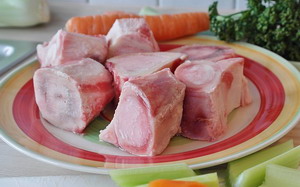 So what foods have collagen in them? Collagen is found in skin, connective tissue, and tendons/joints, as well as in various organs. It is found in all the parts of animals we don’t usually eat here in the US. The one exception common in this culture is bone broth. Bone broth is a delicious base in many different soups, and can easily be consumed just as it is. Other cultures treasure organ meats, tendons, skin, and joints. They know how much good nutrition is found in these tissues. That being said, most Americans will look to taking collagen as a supplemental powder or pill. Collagen is becoming quite popular these days as a way to fight wrinkles and aging in general. Just look around as you are checking out at Costco. The last couple of isles is filled with piles of collagen canisters.
So what foods have collagen in them? Collagen is found in skin, connective tissue, and tendons/joints, as well as in various organs. It is found in all the parts of animals we don’t usually eat here in the US. The one exception common in this culture is bone broth. Bone broth is a delicious base in many different soups, and can easily be consumed just as it is. Other cultures treasure organ meats, tendons, skin, and joints. They know how much good nutrition is found in these tissues. That being said, most Americans will look to taking collagen as a supplemental powder or pill. Collagen is becoming quite popular these days as a way to fight wrinkles and aging in general. Just look around as you are checking out at Costco. The last couple of isles is filled with piles of collagen canisters.
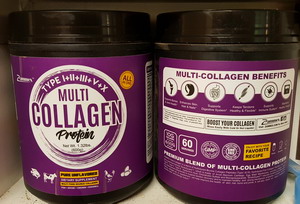 The most common collagen sold is type 1 from bovine (cow) sources. This is also the most important collagen we need from the diet. But many people like myself prefer to purchase collagen with a mixture of 5 or 6 different types of collagen in it. Collagen powder is a very bland powder that mixes easily with most liquids. One popular fad right now is to mix collagen powder into your morning coffee. I am not a coffee drinker, but the idea works well for others. I have a collagen and amino acid mixture with vitamins and other nutrients as a shake each morning. I also mix our collagen into Ellen’s steel cut oatmeal, and even into a cheese substitute I make. I think I have even mixed it into gluten-free sugar-free chocolate chip cookie dough. (Yes, I had to make the sugar-free chocolate chips myself from cocoa butter, cocoa mass, and allulose.)
The most common collagen sold is type 1 from bovine (cow) sources. This is also the most important collagen we need from the diet. But many people like myself prefer to purchase collagen with a mixture of 5 or 6 different types of collagen in it. Collagen powder is a very bland powder that mixes easily with most liquids. One popular fad right now is to mix collagen powder into your morning coffee. I am not a coffee drinker, but the idea works well for others. I have a collagen and amino acid mixture with vitamins and other nutrients as a shake each morning. I also mix our collagen into Ellen’s steel cut oatmeal, and even into a cheese substitute I make. I think I have even mixed it into gluten-free sugar-free chocolate chip cookie dough. (Yes, I had to make the sugar-free chocolate chips myself from cocoa butter, cocoa mass, and allulose.)
 An important note, since our goal is to improve our collagen production, certain nutrients are necessary for building collagen – namely vitamin C and zinc. So make sure you are getting a good amount of each of these. Another super opportunity to help the collagen levels in our skin to reduce those wrinkles, sags, and cellulite crepey skin is to regularly expose the skin areas to infrared light. Many studies have found that infrared light at around 660 nm stimulates the metabolism of the fibroblasts that produce collagen. We had that type of red light set up in the office many years ago for treating the face, but there was little interest in it. I suspect that this is because you need regular, even daily treatments for a couple of months to see the effects. Full body red light panels can run into the thousands of dollars for home use, but you can go the inexpensive route with a red/infrared LED spotlight for spot usage for under $50. Here is a link to my Amazon link page for this.
An important note, since our goal is to improve our collagen production, certain nutrients are necessary for building collagen – namely vitamin C and zinc. So make sure you are getting a good amount of each of these. Another super opportunity to help the collagen levels in our skin to reduce those wrinkles, sags, and cellulite crepey skin is to regularly expose the skin areas to infrared light. Many studies have found that infrared light at around 660 nm stimulates the metabolism of the fibroblasts that produce collagen. We had that type of red light set up in the office many years ago for treating the face, but there was little interest in it. I suspect that this is because you need regular, even daily treatments for a couple of months to see the effects. Full body red light panels can run into the thousands of dollars for home use, but you can go the inexpensive route with a red/infrared LED spotlight for spot usage for under $50. Here is a link to my Amazon link page for this.
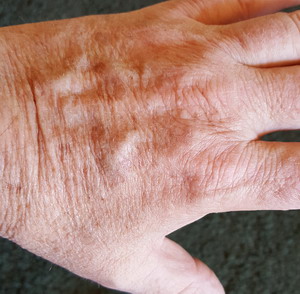 So what can collagen do for you?
So what can collagen do for you?
Improve your skin – reduce wrinkles
Improve the cartilage in your joints
Improve bone matrix for building stronger bones
Improve muscle mass if you are doing resistance training
Improve blood vessels and heart
Strengthen hair and nails
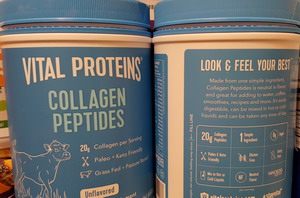 These are all good things and make using collagen a no-brainer. How much do you need? Ellen and I each take a heaping scoop in our shake each morning. That amounts to around 15 grams each. From the studies I have seen, a minimum of 5 grams would be necessary to see any results. That would be a lot of pills, so I recommend using a powdered supplement. Here is a link to a good one. If you eat meat in a nose-to-tail fashion like or forefathers did then you would be getting all the collagen you would need. There are many other nutritional benefits to eating the entire animal rather than just eating muscles. If you are not a meat eater at all then you can take the free-form amino acids I mentioned at the beginning of the article that collagen is made from. Free form amino acids are generally derived from bacteria grown in nutrient vats, so no animals are involved.
These are all good things and make using collagen a no-brainer. How much do you need? Ellen and I each take a heaping scoop in our shake each morning. That amounts to around 15 grams each. From the studies I have seen, a minimum of 5 grams would be necessary to see any results. That would be a lot of pills, so I recommend using a powdered supplement. Here is a link to a good one. If you eat meat in a nose-to-tail fashion like or forefathers did then you would be getting all the collagen you would need. There are many other nutritional benefits to eating the entire animal rather than just eating muscles. If you are not a meat eater at all then you can take the free-form amino acids I mentioned at the beginning of the article that collagen is made from. Free form amino acids are generally derived from bacteria grown in nutrient vats, so no animals are involved.
Do I think collagen is a good idea? Yes, I do.
Take care,
David
